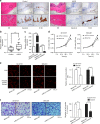Increased miR-214 expression suppresses cell migration and proliferation in Hirschsprung disease by interacting with PLAGL2
- PMID: 30822775
- PMCID: PMC6768286
- DOI: 10.1038/s41390-019-0324-9
Increased miR-214 expression suppresses cell migration and proliferation in Hirschsprung disease by interacting with PLAGL2
Abstract
Background: The miR-214 has been reported to be associated with various diseases, but its involvement in the pathophysiology of Hirschsprung disease (HSCR) is almost completely unexplored.
Methods: In our study, we conducted a series of experiments to unravel the biological role of miR-214 in the pathophysiology of HSCR. qRT-PCR and western blotting were utilized to investigate the relative expression levels of miR-214, mRNAs, and proteins of related genes in colon tissues from 20 controls without HSCR and 24 patients with HSCR. The potential biological role of miR-214 in two cell lines (SKN-SH and SH-SY5Y) was assessed using the CCK8 assay, EdU staining, transwell assay, and flow cytometry. The dual-luciferase reporter assay was used to confirm PLAGL2 as a common target gene of miR-214.
Results: All results suggested that miR-214 is upregulated in HSCR tissue samples compared with controls. Additionally, we found that miR-214 could inhibit cell proliferation and migration by directly downregulating the expression of PLAGL2, and the extent of the miR-214-mediated inhibitory effects could be rescued by a PLAGL2 overexpression plasmid.
Conclusion: Our results revealed that miR-214 is indeed involved in the pathophysiology of HSCR and suppresses cell proliferation and migration by directly downregulating PLAGL2 in cell models.
Conflict of interest statement
The authors declare no competing interests.
Figures






References
-
- Emison Eileen Sproat, McCallion Andrew S., Kashuk Carl S., Bush Richard T., Grice Elizabeth, Lin Shin, Portnoy Matthew E., Cutler David J., Green Eric D., Chakravarti Aravinda. A common sex-dependent mutation in a RET enhancer underlies Hirschsprung disease risk. Nature. 2005;434(7035):857–863. doi: 10.1038/nature03467. - DOI - PubMed
Publication types
MeSH terms
Substances
LinkOut - more resources
Full Text Sources

